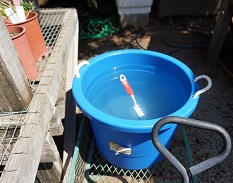By Melanie Cross, Chapter Nursery Manager
8/19/2015
 An issue that has surfaced in native plant nursery and revegetation circles this year is the appearance of deadly exotic pathogens: Phytophthora species, and lots of them. You may know of this algae relative because sudden oak death is caused by an airborne species, P. ramorum. The new pathogens that are showing up are water-borne. Susceptible plants at revegetation sites and other landscapes have been devastated by these “plant destroyers.” Unfortunately, nurseries offer the right conditions to cultivate and disseminate them. This is just what we do not want to do.
An issue that has surfaced in native plant nursery and revegetation circles this year is the appearance of deadly exotic pathogens: Phytophthora species, and lots of them. You may know of this algae relative because sudden oak death is caused by an airborne species, P. ramorum. The new pathogens that are showing up are water-borne. Susceptible plants at revegetation sites and other landscapes have been devastated by these “plant destroyers.” Unfortunately, nurseries offer the right conditions to cultivate and disseminate them. This is just what we do not want to do.
We at the Chapter nursery in Hidden Villa are educating ourselves and joining CANNN (the California Native Nursery Network) to keep up with new information and recommendations. Unfortunately, I have been told to assume we have the pathogens everywhere; that our job is to keep them out of the plants we produce. This requires a major change in our habits, and in the nursery itself. The mantra I have heard is: “Start clean; keep it clean.” You can help us!
The first changes we are making have to do with keeping Phytophthora from coming into the nursery and getting into our production, among them:
- Clean and sterilize the recycled pots, flats etc. we use, and store all in a clean dry area,
- Make sure that our growing media are not infected when coming in or being stored,
- Clean and sterilize our tools and work surfaces (even things like hose nozzles),
- Clean shoes and other items coming in that have been on the ground and
- All incoming plant material is suspect, and should only be accepted from facilities and individuals who use proper sanitation procedures.
Further recommendations will help keep the pathogens from spreading in the nursery through water movement:
- Keep plants up off the ground, so water from rain or irrigation does not splash on plants and
- Avoid standing puddles or moisture movement from potentially infected plants.
Some of these changes are going to be more difficult and expensive for us than others. We are starting with cleaning the gallon pots. First I’m asking that you wonderful people who bring us plastic gallon pots use a stiff brush to remove loose or adhered soil before you drop them off at the nursery. It is better to keep that material out of the nursery all-together. That also makes washing them a more straightforward, but still time consuming, task.
If you want to help out (no green thumb required!) or just to learn more, contact Melanie Cross at This email address is being protected from spambots. You need JavaScript enabled to view it. or (650) 847-1350.
There are a number of videos on this topic available on our website: you can watch them on YouTube at
bit.ly/1Mfah3r or listen to KQED's summary of the problem.
(Original article from the March-April 2015 edition of Blazing Star)
Prior to our Fall 2015 plant sale, we emailed to our Chapter news group a Fact Sheet on Phytophthera so plant sale attendees can make an informed choice when buying California native plants. Here is an updated version of that fact sheet.

